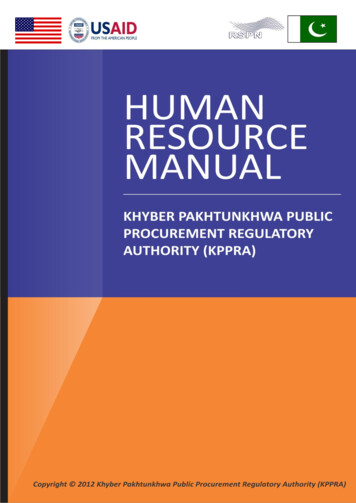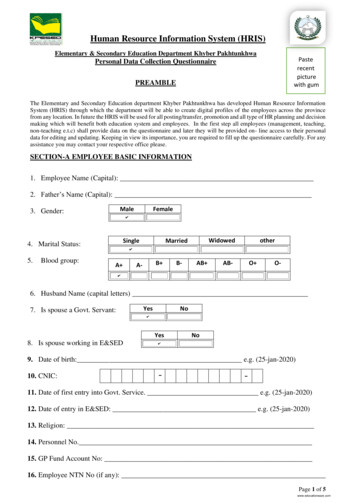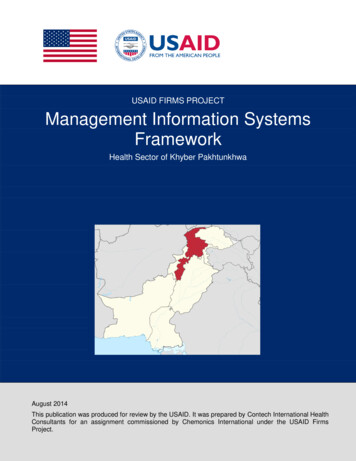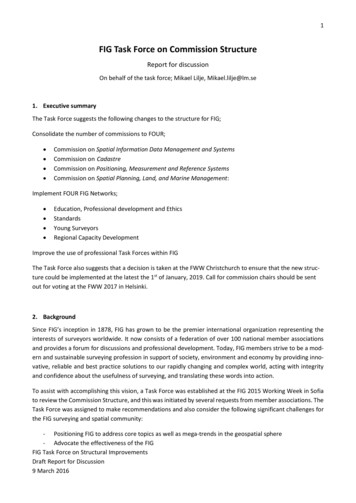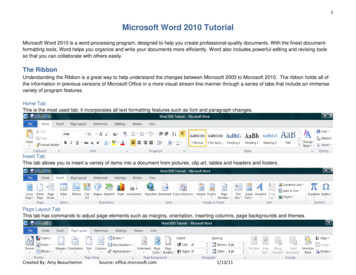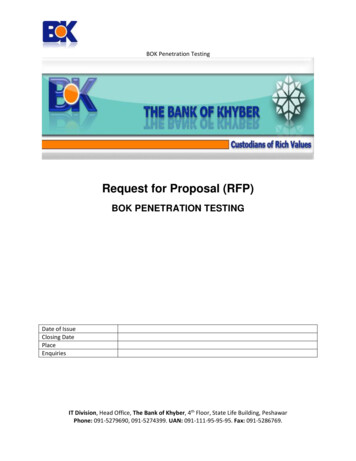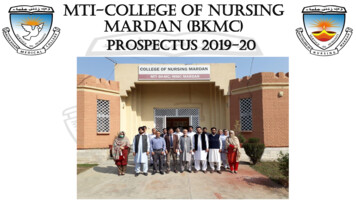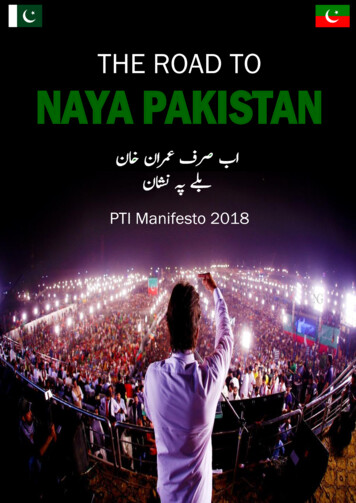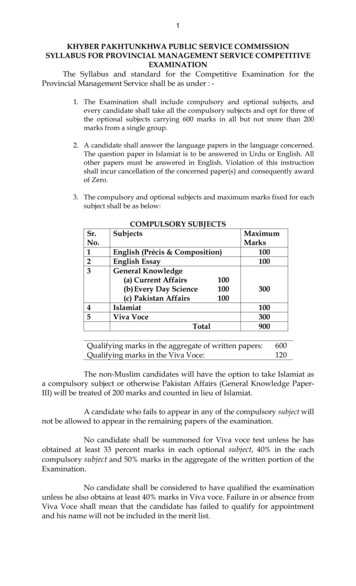
Transcription
1KHYBER PAKHTUNKHWA PUBLIC SERVICE COMMISSIONSYLLABUS FOR PROVINCIAL MANAGEMENT SERVICE COMPETITIVEEXAMINATIONThe Syllabus and standard for the Competitive Examination for theProvincial Management Service shall be as under : 1. The Examination shall include compulsory and optional subjects, andevery candidate shall take all the compulsory subjects and opt for three ofthe optional subjects carrying 600 marks in all but not more than 200marks from a single group.2. A candidate shall answer the language papers in the language concerned.The question paper in Islamiat is to be answered in Urdu or English. Allother papers must be answered in English. Violation of this instructionshall incur cancellation of the concerned paper(s) and consequently awardof Zero.3. The compulsory and optional subjects and maximum marks fixed for eachsubject shall be as below:Sr.No.12345COMPULSORY SUBJECTSSubjectsEnglish (Précis & Composition)English EssayGeneral Knowledge(a) Current Affairs100(b) Every Day Science100(c) Pakistan Affairs100IslamiatViva VoceTotalMaximumMarks100100300100300900Qualifying marks in the aggregate of written papers:Qualifying marks in the Viva Voce:600120The non-Muslim candidates will have the option to take Islamiat asa compulsory subject or otherwise Pakistan Affairs (General Knowledge PaperIII) will be treated of 200 marks and counted in lieu of Islamiat.A candidate who fails to appear in any of the compulsory subject willnot be allowed to appear in the remaining papers of the examination.No candidate shall be summoned for Viva voce test unless he hasobtained at least 33 percent marks in each optional subject, 40% in the eachcompulsory subject and 50% marks in the aggregate of the written portion of theExamination.No candidate shall be considered to have qualified the examinationunless he also obtains at least 40% marks in Viva voce. Failure in or absence fromViva Voce shall mean that the candidate has failed to qualify for appointmentand his name will not be included in the merit list.
2OPTIONAL SUBJECTSThe candidates are required to select optional subjects carrying a total of600 marks, but not more than 200 marks from a single group (The grouping of optionalsubjects are as under):RulesNote: Business Administration Cannot beopted in combination with Note: International Law cannot be ountancy & AuditingEconomicsBusiness AdministrationPublic Administration200200100100910111213Political 010010010014151617Pure MathematicsApplied MathematicsComputer 02002425262728Islamic History & CultureHistory of Pakistan &IndiaBritish HistoryEuropean HistoryHistory of the U.S.A.200200200200100293031323334LawConstitutional LawMercantile LawMuslim Law &JurisprudenceInternational LawInternational y includingexperimental Psychology200English 38394041200
3Provincial Management Service Competitive Examination(Guidelines of the Syllabus)N.B – The topics mentioned under each subject are only indicative and not exhaustive of the fieldcovered by that subject. The candidate should study the whole subject with the help of relevantbooks.1. ESSAY (COMPULSORY)Total Marks – 100Candidates will be required to write one or more essays in English. A wide choice of subjects will begiven.2. ENGLISH (PRÉCIS & COMPOSITION)CompulsoryTotal Marks – 100The examination will be based upon a paper carrying 100 marks and will be geared to test thecandidates’ ability to handle grammatical structure, reading comprehension and analysis and préciswriting and composition.A candidate should be capable of:a.b.Using English correctly and efficiently as a vehicle of communication.Reading, comprehending and analyzing advanced textsGrammar and VocabularyThe candidate’s ability to handle the structure of English will be tested by framing items based upongrammatical categories that usually create problems for foreign students. There shall be no prescribedcourse for this purpose.Reading Comprehension and AnalysisTwo unseen passages shall be given with a fixed reading time and multiple choice questions would beplaced at the end to be answered. The passage for comprehension shall be fairly technical. Thepassages would be selected from writings on economic, social, cultural subjects and international affairs.Précis WritingThe candidates will be required to present an acceptable précis of a given passage. The unseen passagewill be selected from current, economic, social, cultural and international affairs.3. GENERAL KNOWLEDGETotal Marks – 300Paper IEvery Day Science (Compulsory)Marks – 1001. IntroductionNature of Science: Brief History of Science with special reference to contribution of Muslims in theevolution and development of science. Impact of Science on e Physical SciencesConstituents and Structure:- Universe, Galaxy, Solar system, Sun, Earth, MineralsProcesses of Nature:- Solar and Lunar Eclipses; Day and Night and their variation;Energy :- Sources and resources of Energy, Energy conservation;Ceramics, Plastics, Semiconductors;Radio, Television, Telephones, Camera, Laser, MicroscopeComputers, Satellites;Antibiotics, Vaccines, Fertilizers, PesticidesBiological SciencesThe basis of life – the cell, chromosomes, genes, nucleic acidsThe building blocks – proteins, hormones and other nutrients. Concept of balanced diet. MetabolismSurvey of Plant and Animal Kingdom – a brief survey of plant and animal kingdom to pinpointsimilarities and diversities in nature(iv) The Human body – a brief account of human Physiology and Human behaviour
4Paper IICurrent Affairs (Compulsory)Marks – 100Candidates will be expected to display such general knowledge of History, Geography and Politics as isnecessary to interpret current affairs1.2.3.4.5.6.7.8.9.10.11.12.Pakistan’s relations with its neighboursPakistan’s relations with Middle Eastern, African and Far Eastern CountriesPakistan’s relations with big powersInternational Economic Issues and PakistanPakistan’s role in regional and international organizationsNuclear politics in South AsiaStructure of Pakistan’s economy, economic planning and development strategiescentral issues and problems in the Educational SystemsIssues in Pakistan PoliticsSuperpowers and the issues of World OrderMajor Contemporary CrisisMajor Economic, Social and Political issues of the world as reflected and discussed in periodicalsand newspapersPaper IIIPakistan Affairs (Compulsory)Marks – 1001.2.3.4.5.4.Evolution and growth of Muslim society in the Sub-continentIdeology of Pakistan – Definition and elucidation, historical aspects: Muslim rule in the sub-continent,its downfall and efforts of Renaissance. Movements for reforms – Sheikh Ahmad Sarhindi, ShahWaliullah, Aligarh, Deoband, Nadwah, Anjuman Hamiat-e-Islam and other Educational institutions –Sind Madrassah and Islamia College Peshawar. Ideology of Pakistan in the light of speeches andsayings of Allama Iqbal and Quaid-e-Azam.Pakistan Movement – historical developments, important events, role of various individuals,communities and groups.Political Developments in Pakistan since 1947 and efforts for promulgation of Islamic systemLand and People of Pakistan – Geography, Society, Natural resources, Agriculture, Industry,Education with reference to characteristics, trends and problemsISLAMIAT (COMPULSORY)Total marks – 1001.2.3.4.(a)(b)5.(i)(ii)(iii)(iv)(v)6.Basic problems of human life and their solutions, various sources of knowledge – revelation (Wahy)as source of knowledge and solution of human problems. Divinity and Supremacy of wahyNeed of Religion and its role in human life, Islam and other religionsIslam: Its concepts and meanings, Deen and Mazhab, Islamic concepts of universe and humanity,place of Humanity in Islam, man as Vicegerent of Allah, Chief Characteristics of Islamic IdeologyFundamental beliefs and practices of IslamTauheed (Unity of Allah), Risalat (Finality of Prophet hood), Akhirat (Day of Judgment)Salat, Soum, Zakat, Hajj, JihadIslamic way of lifeSources of Shariah: The Quran, Sunnah, Ijma (Consensus), Qiyas and Ijtihad (Reasoning)Social system in Islam: Responsibilities and mutual relationship of members of family, separate roleof man and woman in an Islamic social setup, concept of women’s freedom in Islam, responsibilitiesof man and woman in character-building of new generationMorality in Islam: Concept of morality, relationship of morality and Faith, Islamic principles andmethods of character building, Moral values in IslamIslamic political system: - Legislative system, Judicial systemMuslim ummah: Role and objectives of Muslim UmmahQuranic Ayat and their translationFollowing last 10 surrahs of the Holy Quran and their translations:1. Surrah Al-Feel2. Surrah Al-Quresh3. Surrah Al-Mamoon4. Surrah Al-Kausar5. Surrah Al-Kafaroon6. Surrah Al-Nasr7. Surrah Al-Lahhab8. Surrah Al-Akhlas9. Surrah Al-Falak10. Surrah An-Nas
55.ACCOUNTANCY AND AUDITINGTotal Marks – 200Paper IMarks – 100Accounting: Principles of accounting and their applications to all types of Business Organizations –Banking, Insurance, Investment, Trading and Industrial Concerns, Accounting for non-profitOrganizations, Work-Sheet, Financial Statements, Financial Reporting, Financial Analysis AndBudgeting, Depreciation, PartnershipNote:- Accounting for Executors, Trustees Of Deceased Persons, Liquidators, Receivers, OfficialAgencies, Assignees etc; and accounting for Multinational Corporation will not be includedPaper IIMarks – 100Cost Accounting: Principles of cost accounting, relationship of Cost Accounting To Financial Accounting,Cost Accounting as a tool of management – use of cost information, Cost Flow, Cost Elements, CostsClassification, Process Cost And Job – Order Cost Accounting, Costing For Joint and by-products,Standard Cost Accounting, reconciliation of Financial Accounts with Cost AccountsAuditing: Principles of Auditing, The Accounting System, Its importance to Independent Audit, InternalControl, Internal Audit, Rights and Duties of Auditors, Professional liabilities of an Auditor, Application ofAuditing Principles and Techniques to all types of Trading, Commercial, Industrial, Banking, Insuranceand Investment undertakings. Audit programme, Special Audit Investigation of actual or suspectedFrauds, Limitations Of Audit, Audit Report, Certificates and Opinion as required under Companies Act,Securities Exchange Authority Rules, Auditing and EDP SystemsIncome Tax: Principles for Computing total income and total world income for the purposes of IncomeTax, Self Assessment.Specialized knowledge of Income Tax will not be expected. Candidates will be required to have a soundgrasp of the provisions of Section 10 of the Income Tax Act and a working knowledge – only of Sections9(1), 15, 16(1), 17(1), 19(1),(2),(a), 30(1) & (2), 31(1) 11 No. Schedule (Item No. 66 & 71 to 75) 39(1) &(a) 49, 69 (4) 12 (11). 1st Schedule 53(1), 55(1), 56, 61, 59(1), 60, 62, 68, 12(2) and the connected rulesof the Income Tax Ordinance 1979 as amended to date.Business Organization and Finance: Nature and scope of Business Organization, Forms of BusinessOrganization – Sole Proprietorship, Partnership, Joint Stock Company, Cooperative Society, CompanyPromotion and Management, Insurance, Business Combinations, Principles Of Business Finance – ShortTerm, Intermediate Terms and Long Term Financing, Expansion and Contraction, Ratio Analysis –Sources and Flow Statement, Role of Financial Institutions6.AGRICULTURETotal Marks – 100(a) Natural Resources (Land, Water, Biological, Environmental, Solar and Energy) as bases foragricultural production. Agriculture as integrated system of components like Crops, Livestock,Fisheries, Forestry, Range Management, Socio-Economics etc. Role of research and newertechnologies in current and future agriculture in Pakistan.(b) Elements of climate and their relationship with crop growth, Factors of soil, Soil formation anddevelopment of Soil profile, Soil texture and structure and their management, Soil fertility andfertilizer requirement of various soils and crops, Role of organic matter in soil, Water requirement ofcrops and water use efficiency, Cropping pattern and crop relations, Systems and types of farming;Nature, formation and reclamation of salt affected and water-logged soil, Soil erosion andconservation(c) Physiology of growth and development, growth curves, growth regions, RGR, NAR and LAR inrelation to biomass production, Seed growth and assimilate partitioning, Harvest Index,Photoperiodic and thermo periodic responses of crop plants, photorespiration, Nitrogen fixation,Nitrogen cycle, factors affecting biological N-fixation(d) The modern concept of genetics, gene and gene function, application of genetics for theimprovement of crops(e) Modern concept of Horticulture industry, Plant propagation, Major management and breedingproblems in fruits and vegetables(f) Pests and diseases in agricultural crops, Principles and methods of pest and disease control,Pesticides – their application and action. Modern concept and principles of insect pest management(g) Role of agriculture in the national economy. Agriculture mechanization. Land tenure and Landreforms. Population problems of rural Pakistan. Major issues in agriculture and agriculturaldevelopment in Pakistan.
67.APPLIED MATHEMATICSTotal Marks – 200Paper IMarks – 100Candidates will be asked to attempt any two questions from Section A and any three questions fromSection BSection AVector Analysis: Vector algebra, scalar and vector product of two or more vectors, function of a scalarvariable, Gradient, divergence and curl, Expansion formulae, curvilinear coordinates. Expansion forgradient, divergence and curl in orthogonal curvilinear coordinates, line, surface and volume integrals,Green’s, Stoke’s and Gauss’s theoremsStatistics: Composition and resolution of forces, Parallel forces and couples, Equilibrium and a system ofcoplanar forces, centre of mass and centre of gravity of a system of particles and rigid bodies, Friction,principle of virtual work and its applications, equilibrium of forces in three dimensionsSection BDynamics: Tangential, normal, radial and transverse components of velocity and acceleration, rectilinearmotion with constant and variable acceleration, Simple Harmonic Motion, Work, Power and Energy,Conservative forces and principles of energy, principles of linear and angular momentum, Motion of aprojectile, ranges on horizontal and inclined planes, Parabola of safety, Motion under central forces, Apseand apsidal distances, Planetary orbits, Kepler’s law, Moments and products of inertia of particles andrigid bodies, kinetic energy and angular momentum of a rigid body, Motion of rigid bodies, Compoundpendulum, Impulsive motion, collision of two spheres and coefficient of restitution.Paper IIMarks – 100Candidates will be asked to attempt any two questions from Section A, one question from Section B andtwo questions from Section C.Section ADifferential Equations: Linear differential equations with constant and variable coefficients, Non-linearequations, Systems of equations, Variations of parameters and the power series method.Formation of partial differential equations, Types of integrals of partial differential equations, Partialdifferential equations of first order, Partial differential equations with constant coefficients, Monge’smethod, Classification of partial differential equations of second order, Laplace’s equation and itsboundary value problems, standard solution of wave equation and equation of heat induction.Section BTensor: Definition of tensors as invariant quantities. Coordinate transformations, Contra variant andcovariant laws of transformation of the components of tensors, addition and multiplication of tensors,contracts and inner product of tensors, The Kronecker delta and Levi-Civita symbol, the metric tensor inCartesian, polar and other coordinates, covariant derivatives and the Christoffel symbols., The gradient,divergence and curl operators in tensor notation.Section CElements of Numeric Analysis: Solution of non-linear equations, use of x g (x) form, Newton Raphsonmethod, Solution of system of linear equations, Jacobi and Gauss-Seidel method, Numerical Integration,Trapezoidal and Simpson’s re? Regula Falsi and iterative method for solving non-linear equation withconvergence, Linear and Lagrange interpolation, graphical solution of linear programming problems.8.ARABICTotal Marks – 200Paper IMarks – 1001. The Pre-Islamic Arabic Literature2. The Quran, its language, contents and style, its influence on the subsequent literature3. Quranic semantics and etymology with special reference to Ibn Manzoor’s Lisan al’Arab andRaghib al-Asfahani’s Mufradat fi Gharib al-Quran4. Literary history and literary criticism – literary movements, classical background, socio-culturalinfluences and modern trends, origin and development of modern literary genres, includingdrama, novel, short story, essay
75. Contribution of Arabs in the fields of science, philosophy and linguistics with special reference toviews of Ibn Khaldun, Al Bairuni, al-Jahiz, Ibn Maskawaih, Ibn Maja, Al-Kasai and Sebawaih6. A short introduction to Pakistan Arabic literature in the fields of prose and poetry7. The contemporary Arabic literature in Egypt, Lebanon and Iraq with special emphasis on theliterature of al-Mahjer and its outstanding representatives such as Jabran Khalil Jabran, Ilia AbuMehdi, Mekhail Naeema and Umer Abu Risha8. A short Essay in ArabicThis paper will require first hand reading of the texts prescribed and will be designed to test thecandidates’ critical abilityPaper IIMarks – 100Poetry1. Imarul Qais: His Maullaqah – “Qifaa Nabki mim Zakraa Habibin Wa Manzih” (complete)2. Zohar Bin Abi Sulma: His Maullaqah – “A Min Umma Aufaa Dimnatun Lam Takalami” (complete)3. Hassan Bin Tabit: The following five Qasaid from his Daiwan: “Lillahi Darru Kaaba ------- Nadamtuhum”4. Labeed: Aftiddiyaru Mahalluha Wa Maqammuha Mahmud Timur: Story “Ammi Mutawalli”5. Taufiq AL-Hakim : Dramas: Sirrul Muhtahiraa from his Book “Masra-Hiyaatu Jufiqal Hakim”6. Dr. Raza M.N Ehsan Elahie: Nafais al Adab , [PUBA (Hon) Course]7. Dr Jalal-al-Khayyat and others: Jarikh-ul-Abad-il-Arabi-il-Hadith8. Dr Taha Hussain: Hadith al-Arabia9. Isa an-Na’uri: Adab al-Mahjer10. George Saidah: Adabuna wal-Udaba fi Adab al-Mahjer11. Dr De Boer: The history of philosophy in IslamNote: Candidates will be required to answer some questions carrying not less than 25 % marks in Arabicalso.9. BOTANYTotal Marks – 200Paper IMarks – 1001. Thallophytesa. Phycology: Origin, evolution, distribution and classification with reference to range, structure, lifehistory, ecology and economic importance of the main groups of algaeb. Mycology and Plant Pathology Structure, development reproduction, classification, phylogeny,physiology and economic importance of the main groups of fungi, Diseases of economicimportance and general principles of their control2. Bryology: Evolution of gametophytes and Sporophytes3. Peteridophyta and Gymnosperms: General structure, life history and evolutionary tendencies,Ontogeny and structure of seed4. Anatomy and Embryology: Primary and secondary issues, Meristems, tissue differentiation,normal and abnormal secondary growth, anatomy of leaf, stem and root, micro andmegasporogenesis, pollination mechanism, fertilization, development of embryo and endosperm,seed dispersal5. Taxonomy of Angiosperms: Systems of classification, Rules of botanical nomenclature, Conceptsof speciation, introduction to modern trends in plant taxonomy, Bio-systematics, chemotaxonomyand numerical taxonomyPaper IIMarks – 1001. Plant physiology: Plant water relations, osmotic quantities, absorptions, transpiration, role ofessential mineral elements, their uptake and distribution, growth and development, planthormones, photoperiodism, vernalization, Dormancy and Seed germination. Biochemistry ofcarbohydrates, proteins and fats with reference to plants. Enzymes, plant pigments,photophosphorelation, path of carbon in photosynthesis, oxidative phosophorelation (respiration),nitrogen and fat metabolism2. Ecology: Influence of climatic, edaphic and biotic factors on plant growth, Sampling techniques,Major formations in relation to climatic zones, Concepts of ecosystems and their productivity,Ecological energetics, efficiency, pyramids, food chains and trophic levels3. salinity and water logging in Pakistan, causes, reclamation, soil erosion, methods of control andconservation, pollution and conservation of natural resources4. Cytology: Detailed study of ultra structure of cell. Mitosis and meiosis. Significance of meiosis5. Genetics:
8(a) Mendalian Genetics, Linkage, Crossing over, sex linked genes, lethals, balanced lethals,mutation, polyploidy(b) Biochemical Genetics: Bi-chemical nature of hereditary material, genetic code, Fine Structure ofgene, transduction and transformation6. Evolution: Theories of evolution, Neo-Darwinism, Neo-Lamarckism, Adaptive Mutations10. BRITISH HISTORYTotal Marks – 200British History – The history of the British Isles and of the British Empire and CommonwealthPaper IMarks - 100From 1688 to 1850Paper IIMarks – 100From 1850 to the present dayNote: - Credit will be given in both the papers, not only for precise presentation of facts, but also for soundcritical judgment.11. BUSINESS ADMINISTRATIONTotal Marks – 100Candidates will be asked to attempt total Five questions. They will attempt at least one question (out oftwo) from each part. Short note within the question (without choice) can also be givenPart IManagement1. Nature and scope of Management – Different Schools of thought2. Planning – Planning process, planning tools, Change Management3. Organization – Type of Organization, Theory of Organization, Group dynamics, staffing4. Actuating – Leading, approaches to Leadership – Coordinating, communicating, motivating5. Controlling – Budgetary control, Budgetary processPart IIPrinciples of Marketing1. An overview of Marketing2. Marketing’s role in Society and inside a Firm3. Environment of Marketing4. Strategic Planning and Marketing5. Marketing Mix i.e. product,. Pricing, place (Distribution, Channels), Wholesaling, Retailing, SalesPromotion (Advertising, Public Relations)6. Global MarketingPart IIIFinancial Management1. Nature and scope of Financial Management2. interpretation of Financial Statement – Ratio Analysis, Trend Analysis – Common Size Analysis3. Time Value of Money – Concept of TVM, Net Present Value, Pay Back Period, Internal rate ofreturn4. Working Capital Management – Cash Management, Receivable Management, InventoryManagement5. Portfolio Management – Types of Investment, Financial Securities, Diversification Of Risk6. Accounting – Accounting cycles, preparation of Financial Statements, Balance Sheet, IncomeStatement
912. CHEMISTRYTotal Marks – 200Paper IMarks – 1001. Atomic structure – Quantum theory, Schrodinger equation, Particle in box, hydrogen atom,hydrogen moleculeion, hydrogen molecule, Theories of hydrogen and metallic bonding2. Electrochemistry – Ionic equilibria, theory of strong electrolytes, Cbye-Huckel theory of activitycoefficients, galvanic cells, membrane equilibria and fuel cells. Theories of Acids and Bases,glass electrode, measurement of pH, electrolysis, over voltage and corrosion3. Thermodynamics – First law of Thermodynamics, internal energy, enthalpy functions,thermochemisty, Entropy and second law of thermodynamics. Free energy and chemicalequilibrium4. Chemistry of the following Elements – Oxygen, Carbon, Chlorine, Silicon, Nitrogen, Phosphorus5. Metallurgy of the following Elements - Copper, Aluminum, Iron and Silver6. Inorganic Chemical Industries – Sulphuric Acid, Fixation of Nitrogen, Chemical Fertilizers, Semiconductivity devices, Cement, Glass and Ceramics7. Chemistry of transition Elements – General characteristics of the group based on the electronicconfiguration of elements, complex compounds, nature of coordinate bond, historicaldevelopment, applications of Valence Bond, molecular orbital and Crystal Field theories toexplain the structures of the Complex Compounds8. Pollution – water, airPaper IIMarks – 1001. Theory of chemical bonding – Elements of Valence bond and molecular orbital theories (idea ofbonding, non-bonding and anti-bonding orbitals), Sigma and Pi bonds. Hybridization, Shape ofmolecules2. Chemical kinetics – Rate law and its determination Order of reaction, Experimental methods,Temperature Dependence of rate constants, study of mechanism of a few selected reactions (1stand 2nd under reaction only)3. Surface chemistry and catalysis – Physical adsorption and chemisorptions, surface areadetermination, homogeneous and heterogeneous catalysis, acid-base and enzyme catalysis4. Physical organic chemistry – elements of organic reaction mechanism, optical and geometricisomerism, conformational analysis, resonance. H-Bond and its effects on the properties oforganic compound5. Organic halogen Compounds – Types and synthetic application. Grignard reagents.6. Chemistry of Carbonyl compounds – Types of Carbonyl compounds, preparation and reactions ofAldehydes and ketones7. Aromatic chemistry – structure of Benzene with particular reference to mechanism of ElectrophilicSubstitution reactions8. Organic Nitrogen compounds – Diazonium salts and their synthetic applications, preparation andreaction of aromatic amino compounds, introduction of the study of Dyes with particular referenceto Azodyes9. Chemistry of natural products – Elementary study of Carbohydrates, oils and fats, alkaloids andvitamins10. Industrial organic Chemistry – Organic polymers, fermentation processes including preparation ofanti-biotics, petro-chemical industry13. COMPUTER SCIENCETotal Marks – 100Candidates will be asked to attempt total five questions. They will attempt at least one question fromeach section. Each question will carry 20 marks.Section AComputer Architecture: Introduction to modern machine Architecture, Storage Hierarchy, Main /Virtual / Cache / Secondary memory, CPU, ALU, Peripheral communication, designing of instructionset, stored programme concept, introduction to parallel computing, SIMD / MIMDOperating system: Functions / Types of operating systems, Processes, Interprocesses,Communication / Synchronization / Coordination, Process Scheduling Policies, Visual MemoryManagement Techniques, Paging / Segmentation, File Management SystemsComputer Networks: LAN / WAN / MAN, communication channels, internetworking, internet, networklayer structure, ISO Internet Protocol, OSI / TCP / IP reference model
10Section BStructured and Object Oriented ProgrammingBasics of C/C environment, memory concepts, operators, control structures, selection structures,Array & functions / methods, classes & data abstractions, inheritance and polymorphismData Structures and AlgorithmsPseudo language, functions, iteration, recursion, time / complexity analysis, stacks queue, hashing,linked list, searching, sequential, binary, sorting algorithms, graphic algorithms, tree algorithms, trees,ADTs, implementation using structured / object oriented languagesSoftware EngineeringIntroduction to software engineering, software life cycle, software design methodologies, structured /object oriented, software documentation and management, introduction to CASE toolsSection CDatabase ManagementData, Models, E R Models, Relational Database concepts, SQL normalization, Database DesignWeb ProgrammingHTML, CGI, PERL, JAVA, Applet / Script, WWW, Web based interface designComputer GraphicsFundamentals of input, display and hard copy devices, scan conversion of geometric primitives, 2Dand 3D geometric transformations, clipping and windowing, scene modeling and animation,algorithms for visible and surface determination14. CONSTITUTIONAL LAWTotal Marks – 100Constitutional law – Principles of constitutional law with special reference to United Kingdom, UnitedStates of America, France, former Union of Soviet Socialist Republic, Pakistan and India15. ECONOMICSTotal Marks – 100Paper IMarks – 1001. Micro Economics: Consumer Behaviour, Determination of market demand and supply, theory ofthe Firm, producer’s equilibrium pricing of the factors of production2. Macro Economics: Basic economic concepts, National Income Accounting, consumption functionand multiplier, determination of equilibrium level of income and output, inflation3. Money and banking: Functions of money, Quantity Theory of money, the Fisher and CambridgeFormulations, systems of note issue, credit creation, functions and central banks, instruments ofcredit control, Theory of Liquidity Preference4. Public Financing: Government expenditure, sources of government revenue, types of taxes,incidence of different taxes, public debt, objectives, methods of repayment, deficit financing5. International Trade: Theory of comparative cost, arguments for protection, balance of payments,international liquidity, international money and banking institutionsPaper IIMarks – 100Pakistan’s Economy1. Definition and measurement of development, characteristics of under development, rethinking onthe concept of development, Growth vs. Redistributive Justice, absolute and relative poverty,basic needs approach2. Planning experience of Pakistan: A critical evaluation of the strategy of economic planning3. Agricultural development in Pakistan: Changes in agriculture policies over plan periods, majormonetary and fiscal measures to promote agricultural development, Green Revolution strategyand its implications for growth
Sind Madrassah and Islamia College Peshawar. Ideology of Pakistan in the light of speeches and sayings of Allama Iqbal and Quaid-e-Azam. 3. Pakistan Movement - historical developments, important events, role of various individuals, communities and groups. 4. Political Developments in Pakistan since 1947 and efforts for promulgation of Islamic .
